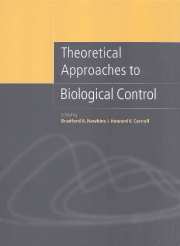Book contents
- Frontmatter
- Contents
- List of contributors
- Preface
- Part I Biological control theory: past and present
- Part II Ecological considerations
- Part III Spatial considerations
- Part IV Genetic/evolutionary considerations
- 13 Population dynamics and the evolutionary stability of biological control
- 14 Genetic conflict in natural enemies: a review, and consequences for the biological control of arthropods
- 15 The evolution of overexploitation and mutualism in plant–herbivore–predator interactions and its impact on population dynamics
- 16 A Darwinian view of host selection and its practical implications
- Part V Microbes and pathogens
- Index
16 - A Darwinian view of host selection and its practical implications
from Part IV - Genetic/evolutionary considerations
Published online by Cambridge University Press: 13 August 2009
- Frontmatter
- Contents
- List of contributors
- Preface
- Part I Biological control theory: past and present
- Part II Ecological considerations
- Part III Spatial considerations
- Part IV Genetic/evolutionary considerations
- 13 Population dynamics and the evolutionary stability of biological control
- 14 Genetic conflict in natural enemies: a review, and consequences for the biological control of arthropods
- 15 The evolution of overexploitation and mutualism in plant–herbivore–predator interactions and its impact on population dynamics
- 16 A Darwinian view of host selection and its practical implications
- Part V Microbes and pathogens
- Index
Summary
Introduction
The process by which parasitoids select their hosts can be viewed in two different, but complementary, ways. The first seeks to understand the proximate cause of events by which parasitoids select hosts (the ‘how’ questions). This involves behavioral and physiological studies that show how the parasitoid interacts with its environment to locate its hosts. The second way in which to view host selection is to understand the ultimate reasons why a parasitoid selects a host (the ‘why’ questions). This involves studies that show how different strategies influence the parasitoid's reproductive success and, therefore, the Darwinian fitness of the searching parasitoid. Thus, the researcher aims to understand why the parasitoid chooses a particular host type among those that are available.
Our aim in this chapter is to emphasize the ‘why’ of host selection by parasitoids and how this understanding can aid in identifying suitable natural enemies for biological control. It can also aid in creating conditions within a crop that maximize their success. We will also emphasize that a successful understanding of the ultimate causation of host selection requires a thorough knowledge of both ‘how’ parasitoids select their hosts and the natural history of the system under study. To illustrate this point, we focus on two parasitoid systems of practical importance, the Trichogramma–lepidopteran system and the Aphytis–red scale system.
- Type
- Chapter
- Information
- Theoretical Approaches to Biological Control , pp. 283 - 304Publisher: Cambridge University PressPrint publication year: 1999
- 7
- Cited by



